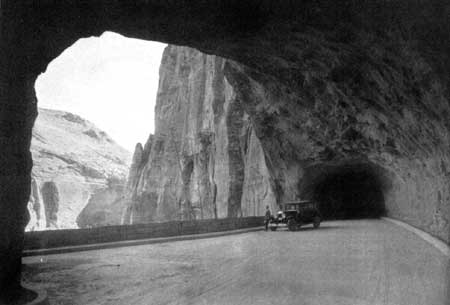![]()
MENU
SECTION I
SECTION II
History
Needs
Geography
Historic Sites
Competitors
Economic Aspects
SECTION III
Federal Lands
State and Interstate
Local
SECTION IV
Division of Responsibility
Local
State
Federal
![]() Circulation
Circulation
SECTION V
Recreational Use of Land in the United States
SECTION IV
PROGRAM FOR DEVELOPMENT OF THE NATION'S RECREATIONAL RESOURCES
5. CIRCULATION SYSTEMS
Conclusions
From the foregoing general statement the following conclusions are presented:
The recreational use of the highway system of the United States plays a very large share in our national recreation scheme. Traffic over this system is now more than one-half recreational traffic. While some routes are primarily for commercial use these form a small percentage of our entire highway scheme. There are others that are primarily recreational in use and on which the commercial traffic is incidental. Between these extremes we have the larger share of the highway system which carries both recreational and commercial traffic. It is estimated that recreational use forms at least 60 percent of the total use of automobiles.
The motor vehicle as a means of mass transportation is relatively new and is making rapid strides in development. It is logical to assume that the use of the motor vehicle will be a changing thing for some time to come. The mechanical development of the automobile, developments in highway design, and developments in the attitude of the people toward its use, are all in the process of change.
Beginnings have been made in the design of highways as a specialized type primarily for recreational use.
(a) The parkway in metropolitan areas has proved itself and will no doubt come into more general use. It will always be justified by traffic before it is constructed and in most cases will be built as a relief to an existing congested traffic artery.
(b) The State highway systems are units within a national highway system, and may follow the same procedure. Traffic will be guaranteed by an existing congested route between two points before a parkway for passenger vehicles is constructed as a means of relieving this congestion.
(c) The Federal Government in the emergency program, through the National Park Service and the Bureau of Public Roads, is authorizing the construction of one parkway and a survey of two others—first as a means to relieve unemployment and second, as an experimental parkway to provide a recreational route through an area containing natural scenic qualities. Such parkways are being constructed with the expectancy that they will be a tourist attraction and by their own qualities develop the traffic to justify them. These are in contrast to the metropolitan parkway which is justified from a traffic viewpoint before it is constructed.
(d) Units in a State highway system that carry a larger percentage of passenger vehicle traffic offer an opportunity for the development of a type of trafficway somewhere between the parkway and the highway. The use of frontage and access restrictions might be introduced to a limited extent rather than to the complete degree with which they are applied to the parkway. The scenic easement and other restrictions of roadside development, such as zoning and architectural and landscape control of development in abutting property, might very profitably be used. The idea suggested in this section would apply to highways in thinly populated areas where the natural scenery is of such quality that it would attract visitors, and where the traffic over the highways is a mixture of commercial and recreational travel, the larger percentage being recreational—yet where the total is not sufficient to warrant the construction of two traffic arteries, one for commercial and the other for recreational traffic.
Since the automobile plays such an important part in the recreational scheme of the Nation, it is recommended:
1. That the Federal Government make a survey of the national highway system, to include, particularly, the development and design of highways and parkways that are expressly laid out for recreational use.
2. That this survey (the survey referred to here is a survey of conditions and is not to be confused with the word survey as used in highway construction) be maintained annually in order that there may be a permanent record of trends in the development of the recreational use of highways.
3. That the National Park Service be authorized to advise and assist other governmental agencies in their studies of the recreational use and design of parkways and highways.
4. That the existing provision for parkway surveys in the Appalachian Mountains be enlarged to include a survey of a parkway from Canada to the Gulf through the Appalachian Range. The question of the responsibility for construction of such a route, i. e., whether it should be State, Federal, or a combination of State and. Federal, need not be determined at present.
5. That the Federal Government go no further than said survey of the Appalachian route as a definite project until a reasonable amount of such parkway has been constructed and has proved its usefulness.
6. That the Bureau of Public Roads and the States, with the advice of the National Park Service, be authorized to consider parkways upon other sections of the country as additions to the Federal aid systems or parts of the State highway systems.

PHOTO 33.—The Zion-Mount Carmel highway pierces the cliffs,
offering from occasional galleries splendid views of the canyon
landscape of Zion National Park.
Last Modified: Fri, Sep. 5, 2003 10:32:22 am PDT
http://www.cr.nps.gov/history/online_books/recreational_use/chap4-5a.htm
![]()

 Top
Top